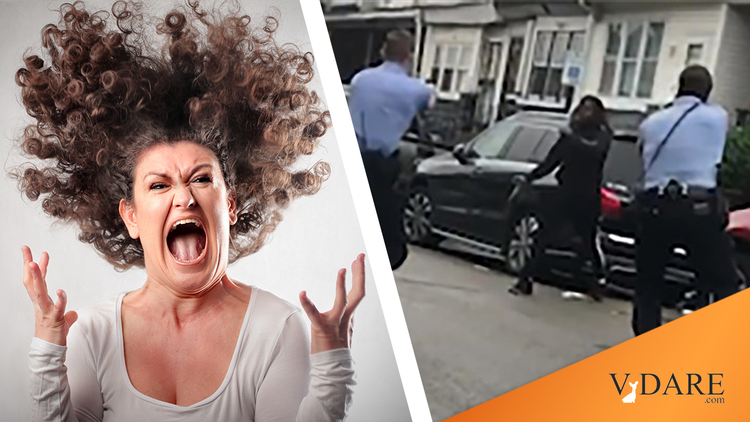
NYT Advice For Aspiring Termagants: Scold Anyone You Overhear Asking If The Latest Aspiring/Expiring Rapper In The Headlines Resisted Arrest
By Steve Sailer
10/29/2020
From the New York Times, an advice column on how to be an even more insufferable anti-white harpy than you already are, a Karen Against Racism.
How to Be an Active Bystander When You See Casual Racism
Oct. 29, 2020
By Ruth Terry
We’ve all been there.
At a dinner party. In line at the post office. On a Zoom meeting. You can feel it coming: that awful joke your friend likes to tell about immigrants. Questions like “Don’t all lives matter?” or “Did he resist arrest?” The discomfort becomes palpable. Your gut twists. God, I hope someone says something, you think with increasing desperation. And so does everyone else.
Everyone else just hates it too when somebody asks “Did he resist arrest?” thereby violating the Negative First Amendment: “The Black man’s right to resist arrest shall not be abridged nor even questioned.” Asking a basic factual question about whether a Black man resisted arrest is a megaaggression. Of course he resisted arrest. That is his duty in 2020 America.
This phenomenon, in which no one in a group of witnesses chooses to disrupt a problematic event, is called the bystander effect, said Thomas Vance, a national certified counselor and a postdoctoral psychology fellow at the New School for Social Research in New York.
“We like to think that we live in a world where people will jump in,” Dr. Vance said in an email, but “the greater the number of people present, the less likely people are to help a person in need or distress.”
Seriously, I’ve seen this happen, such as when I was one of about 1000 pedestrians to see a woman jump off a bridge into the Chicago River at rush hour, but I was the only one to get the life preserver and drop it to her. But my impression is it’s not exactly true: definitely the more witnesses, the lower the per capita likelihood that anyone will respond, but the higher the likelihood that someone will respond. I happened to be one of the few pedestrians who’d noticed that there was a life ring on a rope behind glass at the northeast end of the bridge. If she’d jumped off the Madison Street bridge at midnight in front of ten pedestrians, the odds that any one of the ten would have known about the life buoy would have been much lower.
But, anyway, research into the Bystander Effect was traditionally about things like rescuing people from drowning, not about punishing people for asking “Did he resist arrest?”
“This happens because being part of a large crowd makes it so no single person has to take responsibility for an action,” he added.
This diffusion of responsibility can make well-intentioned people complicit in whatever acts of violence or discrimination they silently witness.
To avoid that silent complicity, people can learn to become active bystanders: individuals who work to create cultures that actively reject harmful or discriminatory behavior through targeted interventions.
What exactly is an active bystander?
First, let’s talk about the difference between an ally and an active bystander.
An ally is someone who “does not suffer the same oppressions” as you do but who “supports your struggle for rights and freedom,” Micki McElya, a history professor at the University of Connecticut, wrote in the Boston Review.
Absent from that definition is action. Active bystanders see something bad happen and make discreet choices to respond to the concerning behavior, said Monica Reyna, a violence prevention educator at the Advocates, a nonprofit in rural Idaho. That can take many forms, such as recording suspected police brutality or challenging everyday microaggressions like dinner-table racism. It can be leaning into humor to unpack “compliments” — for example, your boss describes a Black colleague as “articulate,” the subtext being that this is somehow exceptional — or educating friends about the problematic origins of commonplace expressions. …
Even your physical presence can be enough to keep someone from being the target of racial violence, said LaVonne Pepe, a social worker and a senior trainer at Alteristic.
A perusal of the federal Bureau of Justice Statistics’ National Criminal Victimization Survey might prove eye-opening to people who assume blacks are in terrible danger of Racial Violence.
… Active bystanders should strive to intervene early and often.
… That said, there is no statute of limitations on stepping up. If you miss your window, follow up with the perpetrator later in a private conversation. Or share resources through email or social media.
So, there’s no statute of limitations on canceling Joe Biden for something he has said during his 48 years as a national political figure? Or at least there wouldn’t be after November 3 (until then, Joe’s history is just a foggy blur).
… I try to do this but it’s so hard. I’m exhausted.
It is hard! The fatigue that we all feel is real and it is normal.
